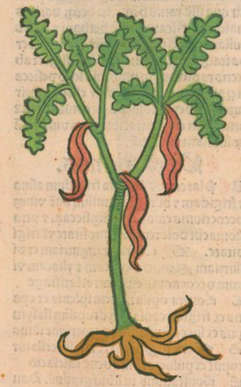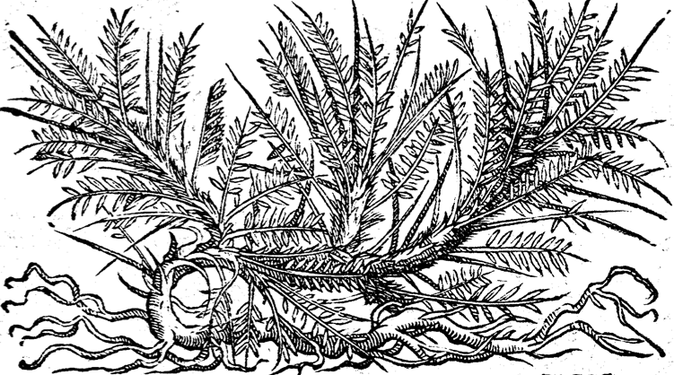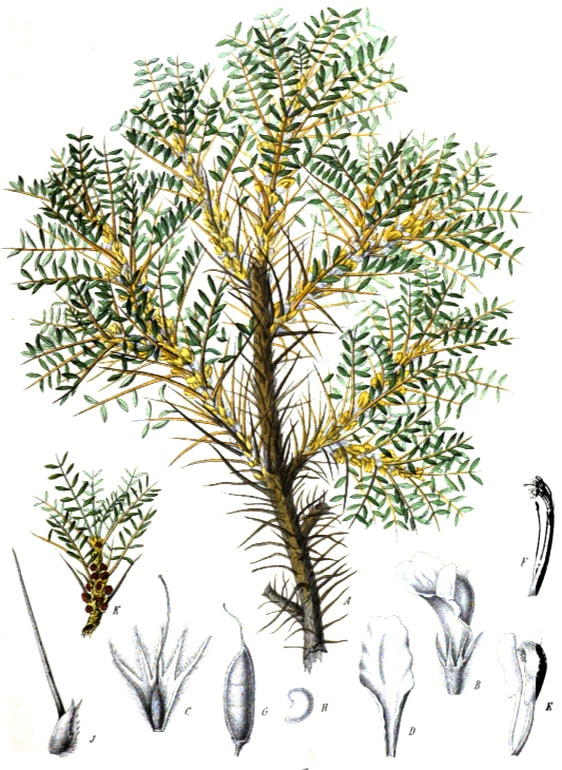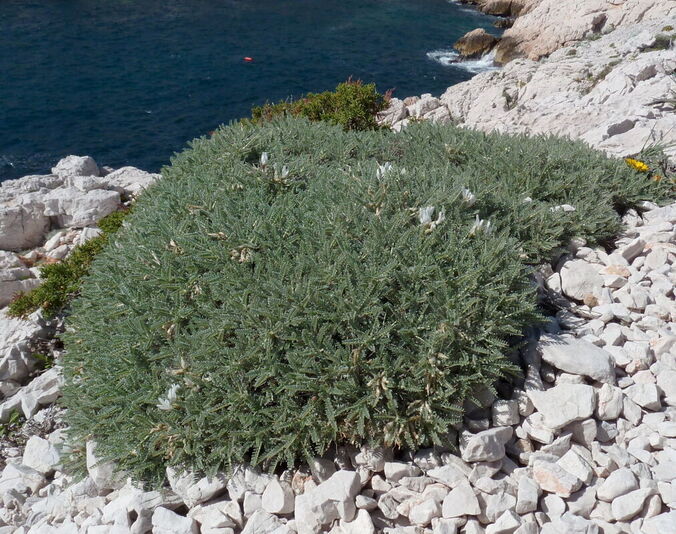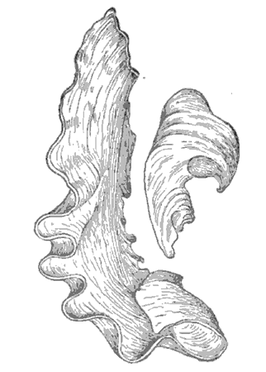Sentry Page Protection
Tragacantha, Gum Tragacanth
Kateera, Katira (Unani)
Ortus Sanitatis, Meydenbach, 1491
Dioscorides Materia Medica,
Mathias, 1563
Mathias, 1563
Atlas der officinellen pflanzen (2), Felix, 1899
Ribbons of Gum Tragacanth
Notes on Pharmacognosy
Otto Augustus Wall, 1902
Notes on Pharmacognosy
Otto Augustus Wall, 1902
Botanical name:
Astragalus spp.
Standard species of Astragalus used include:
Parts used:
Gum
"That which is clear, small, light, smooth, pure and not full of dirt or filth, white and in small slender and curled pieces, is accounted best" (Salmon, Seplasium)
Temperature & Taste:
Neutral, moist. Sweet
Some texts have stated it to be Cool, dry. Some said Neutral in respect of Heat, and moist. Some have held it Warm and moist. Unani Pharmacopoeia says it is moderate and moist. Salmon also said it was Temperate.
Classifications:
2E LENITIVE. 2G. CLEANSING. 2O. ASTRINGENT. 2S. STRENGTHENING. 2W. SARCOTICS
3E. DIURETIC. 3F. LITHONTRIPTIC. 3L. ANTI-TUSSIVE
4a. CEPHALIC. 4d. PECTORAL. 4e. STOMACHIC. 4j. NERVINE
Astragalus spp.
Standard species of Astragalus used include:
- A. tragacanth (Asia minor, Persia)
- A, gummifer (widely distributed through central Asia)
- A. cretica, A. brachycalyx (Kurdistan)
- A. adscendens, A. microcephalus, A. pycnoclaudus, A. fluccosus (Persia)
- A. stromatodes (Syria)
- A. verus (Persia, Asia Minor)
- A. gossypinus, A. compactus, A. rahensis
Parts used:
Gum
"That which is clear, small, light, smooth, pure and not full of dirt or filth, white and in small slender and curled pieces, is accounted best" (Salmon, Seplasium)
Temperature & Taste:
Neutral, moist. Sweet
Some texts have stated it to be Cool, dry. Some said Neutral in respect of Heat, and moist. Some have held it Warm and moist. Unani Pharmacopoeia says it is moderate and moist. Salmon also said it was Temperate.
Classifications:
2E LENITIVE. 2G. CLEANSING. 2O. ASTRINGENT. 2S. STRENGTHENING. 2W. SARCOTICS
3E. DIURETIC. 3F. LITHONTRIPTIC. 3L. ANTI-TUSSIVE
4a. CEPHALIC. 4d. PECTORAL. 4e. STOMACHIC. 4j. NERVINE
Uses:
1. Stops Cough, Strengthens the Lungs:
-tickling Coughs, Hoarseness
-Lung weakness from Qi or Yin deficiency
2. Strengthens Spleen, Benefits Qi:
-in various formulas to nourish and strengthen; good for deficiency and weakness
-lack of energy, poor immunity
-an important corrective for harsh and irritating medicines (Unani)
3. Strengthens the Exterior, Stops Sweating:
-'stops the pores' (Salmon)
-sweating from deficiency; spontaneous sweating
-strengthens immunity and protects from infection
4. Clears Heat, Nourishes Yin:
-nourishes Yin of Lungs, Stomach, Bowels and Kidneys
-restores in Consumption, Wasting and after long illness, Hectic Fever
-used for burning sensations of the body
-Nourishes Sperm
5. Clears Heat, Promotes Urine:
-sharp and scanty urine
-Strangury and heat of the urine. (dissolved in Sweet wine)
6. Mucilaginous:
-Very good for making emulsions and mucilage.
-Used for the suspension of insoluble or heavy powders, and to give consistency to Lozenges and Pastilles etc.
7. Promotes Bowel Movement:
-a gentle laxative; used for 'Gnawing of the Bowels'.
8. Externally:
-Dissolved in milk, it was used as an Eyewash for ‘weals and scabs that grow on the eyelids.’ (Culpeper)
-in plasters and poultices for Wounds, especially of the sinews and nerves. (Culpeper)
-Mucilage of Tragacanth has been used as an external application to burns.
Dose:
Powder: 200mg–1 gram
For Cough and Hoarseness, a licorice stick was dipped into the fine powder and sucked.
It was often used as a mucilage in the following manner: take two drams of Gum Tragacanth, add an eighth of a pint of any distilled water, mix well and let sit overnight. In the morning it will be a mucilage, which may then be used as is, or mixed with a suitable powder, and formed to form troches.
Correctives:
1. Aniseed (Unani)
2. Celery seed; Parsley seed
3. Gourd seed, Wax Gourd seed
Substitutes:
1. The gum of Cochlospermum religiosum is known as Indian Tragacanth and is used synonymously
2. Sterculina urens gum has also been used in India
3. Gum Arabic or Acacia gum can be used
4. Sweet Gourd / Melon seeds (Unani)
5. Galen said Sarcocolla has similar properties, but is weaker.
6. In some cases, extract of Astragalus Huang Qi (10:1) can be used for Tragacanth 1:1 in formula.
Powder: 200mg–1 gram
For Cough and Hoarseness, a licorice stick was dipped into the fine powder and sucked.
It was often used as a mucilage in the following manner: take two drams of Gum Tragacanth, add an eighth of a pint of any distilled water, mix well and let sit overnight. In the morning it will be a mucilage, which may then be used as is, or mixed with a suitable powder, and formed to form troches.
Correctives:
1. Aniseed (Unani)
2. Celery seed; Parsley seed
3. Gourd seed, Wax Gourd seed
Substitutes:
1. The gum of Cochlospermum religiosum is known as Indian Tragacanth and is used synonymously
2. Sterculina urens gum has also been used in India
3. Gum Arabic or Acacia gum can be used
4. Sweet Gourd / Melon seeds (Unani)
5. Galen said Sarcocolla has similar properties, but is weaker.
6. In some cases, extract of Astragalus Huang Qi (10:1) can be used for Tragacanth 1:1 in formula.
Main Combinations:
Gum Arabic & Tragacanth
Lungs
1. To nourish Lung Yin, stop Cough, Consumption, Tragacanth with Gum Arabic, Licorice, Poppy seed, 4 Cold Seeds, Sugar Penids and Camphor (as in Tragacanth Cooling Powder of Nicholas)
2. Cough in Children, melt Tragacanth and Sugar in Milk and drink. (Syrian 'Book of Medicine', Budge, 1913)
3. Dry Cough:
i. Tragacanth and Gum Arabic taken in Barley Water (Herbarius latinus, Petri, 1485)
ii. decoct Licorice and Barley in water, strain and dissolve in Tragacanth (Herbarius latinus, Petri, 1485)
iii. Tragacanth with Poppy seed, Starch, Gum Arabic, Gourd seed, Quince seed (as in Powder for Dry Cough)
iv. Tragacanth with Gum Arabic, Licorice, Poppy seed, Quince seed, Almond (as in Pills of Surfa Qawi, of Unani)
v. Tragacanth with Sugar Candy, Starch, Penids (as in Pilulae Bechica Magistrale)
4. Hot Cough:
i. Tragacanth (2 parts), Licorice (1 part) form an Electuary with Sugar. (Herbarius latinus, Petri, 1485)
ii. Tragacanth with Licorice juice, Gum Arabic, Bitter Almonds (as in Pills for Hot Cough of Zacharia)
iii. Tragacanth with Pine nut, Starch, Gum Arabic, Poppy seed (as in Troches for Cough of Andromachus)
5. Chronic Cough, Wheezing, Breathlessness, Asthma and Hectic Fever, Tragacanth with Pine nut, Almond, Gum Arabic, Licorice, Maidenhair, Orris, Dates (as in Electuary of Pine Nuts of Mesue)
6. Cold Phlegm Cough, Asthma, Shortness of Breath, Tragacanth with Hyssop, Pine nut, Sweet Almond, Linseed, Fenugreek, Cinnamon, Licorice juice, Ginger (as in Tragacanth Warming Powder of Nicholas)
7. Catarrh, Tragacanth with seeds of Poppy, Purslane, Quince, Mallow and Cotton, Chick Pea, Cinnamon, Armenian Earth
8. Consumption and Lung Ulcers, Tragacanth with Pomegranate flower, Dragons Blood, Frankincense, Mastic, Amber, Myrrh (as in Troches for Phthisis and Lung Ulcers of Avicenna)
9. Asthma from Heat, Tragacanth with Licorice juice, Violet, Bitter Almonds, Marshmallow seed, Fennel seed (as in Electuary for Asthma)
10. Pleurisy, Tragacanth with Marshmallow root, Fennel seed, Violet, Licorice juice (Unani)
11. Spitting Blood, Tragacanth with Jujube, Gum Arabic, Aniseed, Mallow seed (as in Decoction for Spitting Blood)
Urinary:
12. Dysuria, Tragacanth with Marshmallow, Licorice, Poppy seed, Barley (as in Powder for Dysuria)
13. Kidney and Bladder Ulcers:
i. Tragacanth with Licorice juice, Myrrh, Frankincense, Mastic
ii. Tragacanth with Dragons Blood, Red Coral, Armenian Earth, Mastic, Melon seed, Winter Cherry (as in Pills for Kidney and Bladder Ulcers)
iii. Tragacanth with Sealed Earth, Red Coral, Starch, Mastic, Dragons Blood, Pearl, Red Coral (as in Tincture for Kidney Ulcers)
Other:
14. Excess Menstruation, Tragacanth with Tormentil, Comfrey, Sorrel, Gum Arabic, Plantain (as in Decoction for Excessive Menstruation)
15. Colitis in Children, Tragacanth with Peony, Mint, Balm, Red Poppy flower (Pharmacopoeia Generalis, 1783)
16. Strong heat with Fever, Burning Fever, Measles, Small Pox, Hectic Fever, Cough, Hemoptysis, Tragacanth with Rose, Gum Arabic, Cucumber seed, Purslane seed, Licorice, Saffron, Starch, Camphor (as in Troches of Camphor of Nicholas)
17. Burning Fever, Tragacanth with Melon seed, Purslane seed, Licorice (as in Troches for Burning Fever of Galen)
18. Opthalmia, Tragacanth (2 drams), Mucilage of Fleabane (3 drams), Rose water, Plantain water (of each sufficient). triturate to form a suitable consistency for topical application for sore, inflamed eyes. (Dispensatorium medico pharmaceuticum Palatinatus, 1764)
19. Burns, Tragacanth with Egg White applied
Major Formulas:
Tragacanth Cooling Powder (Diatragacanth Frigidum) (Nicholas)
Tragacanth Warming Powder (Pulvis Diatragacanth Calidii) (Nicholas)
Powder of Haly
Powder for Dry Cough
Decoction for Spitting Blood
Decoction for Excessive Menstruation
Troches for Burning Fever (Galen)
Troches for Kidney Ulcers (Riverius)
Troches of Camphor (Nicholas)
Troches of Spodium (Trochisci Spodii) (Nicholas)
Troches for Cough (Andromachus)
Black Troches for Cough (Trochisci Bechici) (Mesue)
Pills to Hold in the Mouth for Catarrh
Pills for Hot Cough (Zacharia)
Pills for Kidney and Bladder Ulcers
Electuary of Pine Nuts (Lohoch de Pino) (Mesue)
Electuary of Poppy (Diapapaver) (Mesue)
Cautions:
Generally Safe.
Main Preparations used:
Mucilage
1. Mucilage of Tragacnth:
i. Powdered Tragacanth (2 drams), Boiling Water (8 oz.). Macerate for 24 hours, triturate until entirely dissolved, then strain through linen. (Edinborough)
ii. Powdered Tragacanth (1 part), Cold Water (8 parts). Digest 12 hours, triturate, strain. (Dispensatorium Fuldense, 1791)
2. Demulcent Lohoch:
i. Tragacanth (6 grains), emulsion of Sweet Almonds (4 oz.), Syrup (1 oz.). Mix together. (Ratier)
ii. Tragacanth (½ dram), Sugar (1 oz.), infusion of Red Poppy (6 oz.), Orange flower water (1 oz.). Mix. (Nouveau Formulaire Medicale et Pharmaceutique, 1820)
iii. Powdered Tragacanth (16 grains), Oil of Almonds (½ oz.), Sugar (1 oz.), Water (3 oz.), Orange flower water (2 drams). Mix. (Pharmacopoeia Gallica, 1818)
3. Compound Powder of Tragacanth:
Used as Diatragacanth, Dose: 1–2 scruples
i. Tragacanth, Gum Arabic, Starch (1 part each), White Sugar (2 parts). Mix. (London)
ii. Tragacanth (2 parts), Starch, Sugar (of each 1 part), Mix. (Geneva)
iii. Tragacanth, Gum Arabic, White Sugar (equal parts), Mix. (Belgium)
iv. Tragacanth, Marshmallow root, White Sugar (equal parts). Mix. (Pharmacia rationalis, 1806)
v. Gum Arabic (2 oz.), Tragacanth, Licorice (half oz. each), White Sugar (2 oz.), Mix. (Pharmacopoeia Oldenburgica, 1801)
vi. Tragacanth (1 oz.), Gum Arabic (half oz.), Starch (2 drams), Licorice (1 dram), White Sugar (1 ½ oz.), Mix. (Pharmacopoeia Manualis, Antwerp, 1812)
vii. Sugar Candy (2 drams), Marshmallow root, Tragacanth, Starch (1 dram each), Aniseed oil (6 drops), Mix. (Dispensatorium Fuldense, 1791)
viii. Licorice (half part), Starch (1 part), Sweet Almond blanched, Gum Arabic (3 parts each), Tragacanth (4 ½ parts), Sugar Candy (7 ½ parts), Mix. (Pharmacopee Usuelle, Louvain, 1821)
ix. Tragacanth (2 oz.), Gum Arabic (10 drams), Starch (½ oz.), Licorice (2 drams), Four Cold Seeds (2 drams of each), Poppy seed (3 drams). Mix. (Dispensatorium medico pharmaceuticum Palatinatus, 1764)
Generally Safe.
Main Preparations used:
Mucilage
1. Mucilage of Tragacnth:
i. Powdered Tragacanth (2 drams), Boiling Water (8 oz.). Macerate for 24 hours, triturate until entirely dissolved, then strain through linen. (Edinborough)
ii. Powdered Tragacanth (1 part), Cold Water (8 parts). Digest 12 hours, triturate, strain. (Dispensatorium Fuldense, 1791)
2. Demulcent Lohoch:
i. Tragacanth (6 grains), emulsion of Sweet Almonds (4 oz.), Syrup (1 oz.). Mix together. (Ratier)
ii. Tragacanth (½ dram), Sugar (1 oz.), infusion of Red Poppy (6 oz.), Orange flower water (1 oz.). Mix. (Nouveau Formulaire Medicale et Pharmaceutique, 1820)
iii. Powdered Tragacanth (16 grains), Oil of Almonds (½ oz.), Sugar (1 oz.), Water (3 oz.), Orange flower water (2 drams). Mix. (Pharmacopoeia Gallica, 1818)
3. Compound Powder of Tragacanth:
Used as Diatragacanth, Dose: 1–2 scruples
i. Tragacanth, Gum Arabic, Starch (1 part each), White Sugar (2 parts). Mix. (London)
ii. Tragacanth (2 parts), Starch, Sugar (of each 1 part), Mix. (Geneva)
iii. Tragacanth, Gum Arabic, White Sugar (equal parts), Mix. (Belgium)
iv. Tragacanth, Marshmallow root, White Sugar (equal parts). Mix. (Pharmacia rationalis, 1806)
v. Gum Arabic (2 oz.), Tragacanth, Licorice (half oz. each), White Sugar (2 oz.), Mix. (Pharmacopoeia Oldenburgica, 1801)
vi. Tragacanth (1 oz.), Gum Arabic (half oz.), Starch (2 drams), Licorice (1 dram), White Sugar (1 ½ oz.), Mix. (Pharmacopoeia Manualis, Antwerp, 1812)
vii. Sugar Candy (2 drams), Marshmallow root, Tragacanth, Starch (1 dram each), Aniseed oil (6 drops), Mix. (Dispensatorium Fuldense, 1791)
viii. Licorice (half part), Starch (1 part), Sweet Almond blanched, Gum Arabic (3 parts each), Tragacanth (4 ½ parts), Sugar Candy (7 ½ parts), Mix. (Pharmacopee Usuelle, Louvain, 1821)
ix. Tragacanth (2 oz.), Gum Arabic (10 drams), Starch (½ oz.), Licorice (2 drams), Four Cold Seeds (2 drams of each), Poppy seed (3 drams). Mix. (Dispensatorium medico pharmaceuticum Palatinatus, 1764)
Click the Tabs above for more information on this Medicine
|
'Tragacanth has been known from a very early period. Theophrastus in the 3rd century B.C. mentioned Crete, the Peloponnesus and Media as its native countries. Dioscorides, who as a native of South-eastern Asia Minor was probably familiar with the plant, describes it correctly as a low spiny bush. The drug is mentioned by the Greek physicians Oribasius, Aetius, and Paulus Aegineta (4th to 7th cent.), and by many of the Arabian writers on medicine. The abbreviated form of its name "Dragantum " already occurs in the book "Artis veterinarise, seu mulomediciuse" of Vegetius Renatus, who lived about
|
A.D. 400. During the middle ages the gum was imported into Europe through the trading cities of Italy, as shown in the statutes of Pisa, A.D. 1305, where it is mentioned as liable to impost.
Pierre Belon, the celebrated French naturalist and traveller, saw and described, about 1550, the collecting of tragacanth in the northern part of Asia Minor; and Tournefort in 1700 observed on Mount Ida in Candia the singular manner in which the gum is exuded from the living plant.' (Pharmacographia, Fluckiger & Hanbury, 1879) |
GENERAL / REVIEW
–Exudate gums: occurrence, production, and applications.
–The amino acid composition of the proteinaceous component of gum tragacanth (Asiatic Astragalus spp.).
–Recent progress in the industrial and biomedical applications of tragacanth gum: A review.
–Influence of Storage Conditions on the Stability of Gum Arabic and Tragacanth.
ANTI-INFLAMMATORY
–Comparative anti-inflammatory and hepatoprotective activities of Astragalus gummifer Labill herb and roots in rats.
ANALGESIC
–Antinociceptive activity of Astragalus gummifer gum (gum tragacanth) through the adrenergic system: A in vivo study in mice.
HEPATOPROTECTIVE
–Comparative anti-inflammatory and hepatoprotective activities of Astragalus gummifer Labill herb and roots in rats.
CHOLESTEROL
–The hypolipidaemic effect of gum tragacanth in diet induced hyperlipidaemia in rats.
ANTI-TUMOR
–Action of tumor-inhibitory gum tragacanth on potassium permeability of ascites tumor cells and partial characterization of the cytotoxic component.
–Microscopical observations of the effects of tumour-inhibitory and non-inhibitory samples of gum tragacanth on Landschütz ascites tumour cells.
–Mode of Inhibitory Action of Tragacanth Powder on the Growth of the Landschütz Ascites Tumour.
–Growth inhibition of mouse ascites tumour cells by powdered tragacanth (Tragacanthae pulvis, B.P.).
WOUND HEALING
–Acceleration of skin wound healing with tragacanth (Astragalus) preparation: an experimental pilot study in rats.
–Exudate gums: occurrence, production, and applications.
–The amino acid composition of the proteinaceous component of gum tragacanth (Asiatic Astragalus spp.).
–Recent progress in the industrial and biomedical applications of tragacanth gum: A review.
–Influence of Storage Conditions on the Stability of Gum Arabic and Tragacanth.
ANTI-INFLAMMATORY
–Comparative anti-inflammatory and hepatoprotective activities of Astragalus gummifer Labill herb and roots in rats.
ANALGESIC
–Antinociceptive activity of Astragalus gummifer gum (gum tragacanth) through the adrenergic system: A in vivo study in mice.
HEPATOPROTECTIVE
–Comparative anti-inflammatory and hepatoprotective activities of Astragalus gummifer Labill herb and roots in rats.
CHOLESTEROL
–The hypolipidaemic effect of gum tragacanth in diet induced hyperlipidaemia in rats.
ANTI-TUMOR
–Action of tumor-inhibitory gum tragacanth on potassium permeability of ascites tumor cells and partial characterization of the cytotoxic component.
–Microscopical observations of the effects of tumour-inhibitory and non-inhibitory samples of gum tragacanth on Landschütz ascites tumour cells.
–Mode of Inhibitory Action of Tragacanth Powder on the Growth of the Landschütz Ascites Tumour.
–Growth inhibition of mouse ascites tumour cells by powdered tragacanth (Tragacanthae pulvis, B.P.).
WOUND HEALING
–Acceleration of skin wound healing with tragacanth (Astragalus) preparation: an experimental pilot study in rats.

